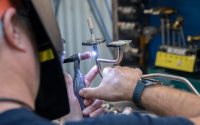Welding | TIG Welding
Welding in Stainless Steel Materials
Welding in stainless steel requires both expertise and precision. At our company, with nearly 50 years of experience, we have built a solid knowledge base in welding, standards,and documentation. This makes us a leading player in stainless steel welding, where we ensure that every project meets the applicable requirements.
TIG Welding of Pipes – Mechanized Precision
When it comes to welding pipes in stainless steel and other metals, we prioritize mechanized TIG welding. This method ensures the highest possible repeatability and consistent high quality, which is crucial for critical applications in industries such as pharmaceuticals and food processing. Our mechanized TIG welding provides a controlled welding process, minimizing the risk of errors and ensuring consistently high quality in every weld. For difficult or unique applications where mechanized welding is not possible, we complement with
manual TIG welding. Our skilled welders have extensive experience working with various metals such as stainless steel, Inconel, Hastelloy, titanium, and aluminum. We handle dimensions from 3 mm to 300 mm in diameter and material thicknesses from 0.5 mm to 25 mm, making us flexible and adaptable to different project requirements.


Manual Welding – Flexibility and Expertise
Despite our focus on mechanized welding, we also have strong expertise in manual welding. This method is used for pipe welding and frame construction welding, where precision and control are crucial. Our staff is trained and experienced in several different welding methods, allowing us to adapt to the specific requirements of each project. This flexibility enables us to deliver high-quality solutions even in the most challenging applications.
Plastic Welding – Specialization in the VNF Method
In certain applications, especially in corrosive environments, plastic is a better material choice than metal. For these situations, we offer plastic welding specializing in the VNF method, which meets the stringent requirements of ASME-BPE. This method is ideal for joining plastic materials and is often used in applications where metal is not suitable due to the risk of corrosion.

